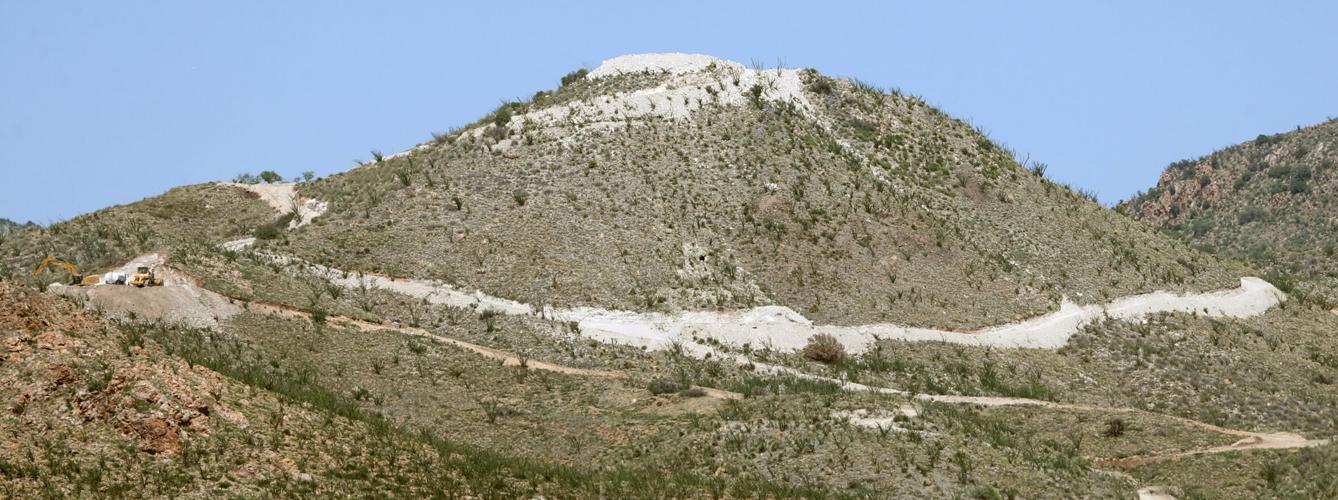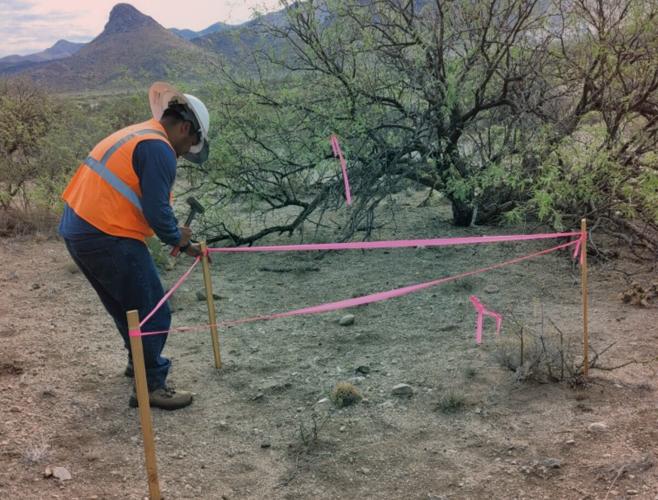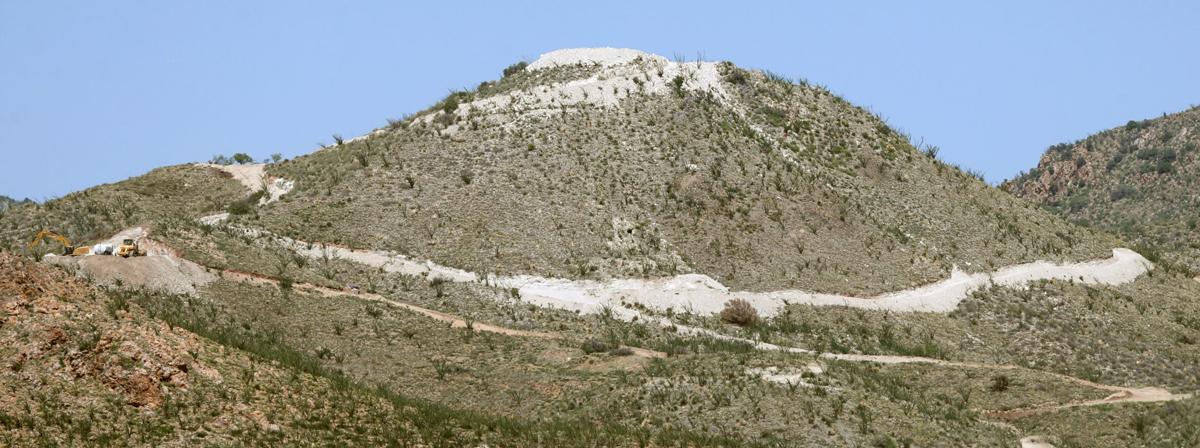The company proposing to build the Rosemont Mine on the Santa Rita Mountains’ east slope is ramping up activity on the west slope facing Green Valley, and it plans to spend another $24 million on drilling and related studies there.
With the proposed Rosemont open pit tied up in court, Hudbay Minerals Inc. says it will spend a total of $35 million by the end of 2021 on the west slope. That includes work it did last fall and spring.
Toronto-based Hudbay intends to spend $14 million of the latest $24 million on drilling and $10 million on hydrogeological, geotechnical and other forms of related studies.
While the future of the west slope area is unknown, a Hudbay vice president said earlier this year that it could have enough copper to support “multiple open pits.”
It also could offer the company an avenue it doesn’t have at Rosemont — avoidance of the major federal oversight that Rosemont has faced.
The west slope area where drilling is taking place, unlike Rosemont, is all private land, although some Bureau of Land Management land adjoins it. Its permitting requirements would be much less strict.
Hudbay’s purpose for the $24 million is to determine the extent and richness of copper deposits underlying the west slope. Company officials see the potential for mining on the west side of the Santa Ritas or a substitute for Rosemont in case Rosemont remains tied up in court.
This drilling follows what Hudbay said are very encouraging results from drilling there last year, that it said produced copper deposits that in some cases are at higher grades than at Rosemont.
The company won’t be ready to discuss the land’s potential until the first six months of 2022, when it expects to complete a preliminary economic assessment of the deposits.
“Any decisions on next steps will be based on the results of that study,” the company said last week to the Star.
Copper demand and prices are
up
Hudbay’s activities on the west slope have sparked a highly positive reaction from a leader of a mining industry advocacy group and stirred serious concern from opponents.
Rick Grinnnell, vice president of the Southern Arizona Business Coalition, praises what he sees as Hudbay’s very unusual large investment in this region’s economy. He calls it a “win-win” for private property and the economy.
University of Arizona professor Brad Ross calls the expanded drilling a sign of the times, given that copper prices have climbed above $4 a pound due in part to expanded demand for copper for electric cars, solar panels and other “green” energy products. Ross is a professor of practice in UA’s Mining and Geological Engineering Department.

Drilling that began in October 2020 indicates "a significant amount of high-grade copper, close to the surface, available to mine," Hudbay said of deposits on company-owned land on the west slope of the Santa Rita Mountains, an area the company calls "Copper World."
Mine opponents such as Save the Scenic Santa Ritas are concerned that additional mining in the mountain range will wreck scenic views from Green Valley and Sahuarita, destroy more biologically diverse open land, and trigger the pumping of more groundwater.
Randy Serraglio of the Center for Biological Diversity is concerned about impacts of the ongoing drilling on vegetation and groundwater, adding it “means that our beautiful Santa Rita Mountains will continue to suffer a death by a thousand cuts.”
Legal advantages on the west
slope
On the west slope, the mining company has a potentially major legal advantage compared to the Rosemont site.
Hudbay owns about 1,250 acres on the west slope in previously patented mining claims.
Mining claims allowed prospectors and explorers to purchase the lands from the federal government more than a century ago at a low price.
At the Rosemont site, it took Hudbay and a predecessor company 12 years to amass the needed federal permits to build the project before two federal court rulings, in 2019 and 2020, overturned two such permits.
One U.S. District Court ruling, concerning Hudbay’s ability to dispose of mine wastes on public lands, is under appeal to a higher court now. The second District Court ruling, which threw out a federal biological opinion on Rosemont’s endangered species impacts, wasn’t appealed. So the U.S. Fish and Wildlife Service will have to rewrite that opinion before the mine can be built.
To mine the west slope land, by contrast, Hudbay most likely won’t need approvals under the National Environmental Policy Act or the federal Endangered Species Act. Those laws come into play for projects either built on federal land or requiring federal permits.
It’s possible that a mining operation would need a federal Clean Water Act permit if it deposits fill material in neighboring washes. But that will be only if the feds change their rules as to which washes are eligible for federal regulation under the act.
All washes on those private lands carry water only after storms. Such ephemeral washes are not covered by the current Clean Water Act rules although they used to be. If the rules are changed again to cover ephemeral washes, which is under consideration, the west-slope washes could face regulation under the Clean Water Act, says the Environmental Protection Agency.
Hudbay would need several state permits to mine on the west slope, including an aquifer protection permit covering its discharges to groundwater, and an air quality permit limiting its emissions into the air. But for Rosemont, those permits from the Arizona Department of Environmental Quality came much more quickly than did its federal permits.

Switchbacks for roads cut through three ridges near Helvetia on the Santa Rita Mountains' west slope, south of Tucson, where Hudbay is doing exploratory drilling and related studies.
‘High-grade’ deposits
sought
Hudbay’s west slope land lies at the end of Santa Rita Road, a nine-mile-long, straight shot south of Sahuarita Road consisting of paved and dirt road sections. The road cuts through mesquite-laden scrub desert before climbing into ocotillo-packed hillsides topped by a row of steep ridgelines and knobs.
Road cuts abound near the ridgelines, but Hudbay says the majority are existing roads, built to serve mining activity dating back more than a century. Numerous trucks carrying water and other materials were driving up and down the dirt roads last week. A front-end loader was crawling back and forth over one of the ridgelines.
With much of Hudbay’s land closed to the public behind “No Trespassing” signs, it wasn’t possible to see if drilling was taking place. Two workers in the area said drilling is occurring now. Hudbay didn’t respond to a question from the Star about that.
The company said its new spending plans come after it reported very encouraging results of drilling activity that began on the site in October 2020. So far, the company said it has drilled 220 holes, to as deep as 500 feet and more.
The company at first planned to drill a total of 40,000 linear feet in holes, later expanded its plans to 70,000 feet and now has completed more than 85,000 feet of drilling. The drilling indicates “a significant amount of high-grade copper, close to the surface, available to mine,” Hudbay said.
The drilling is going on in three long-discussed areas of copper deposits on the ridgeline and the west slope known as Copper World, Peach-Elgin and Broadtop Butte. The three deposits lie more than one mile to nearly three miles north and northwest of the Rosemont site, say estimates made more than a decade ago by the previous owner, Vancouver-based Augusta Resource Corp.
Hudbay calls the entire area Copper World in a public financial document it prepared last spring.
The expansion of drilling will include “additional sites within our private property to help us gain a complete understanding of Copper World,” Hudbay said.
So far, Hudbay has identified four new deposits of copper sulfides and oxides at and near the ground surface, at higher grades than at Rosemont, spanning a total of more than 3 miles long, the company said.
The company has also started and expects to continue mineralogical studies and metallurgical testing of the deposits in the coming months. The company is also using existing geophysical surveys of the property to determine where else to drill.
“All studies, surveys and testing will help us gain a complete understanding of Copper World to determine the scope and economic feasibility for a potential project at the site.”
Previous
company wasn’t
impressed
Eleven years ago this month, however, officials of Hudbay’s predecessor Augusta Resource Corp. gave a less favorable picture of these three deposits’ potential in letters to a Rosemont consultant, Westland Resources Inc.
Based on past drilling conducted at Copper World, Broadtop Butte and Peach-Elgin — which consisted of far fewer holes than Hudbay has drilled — Augusta official Mark Stevens estimated the deposits contained a fraction of the copper resources available at the Rosemont site.
Because of that, Augusta Resource did little evaluation of the sites, wrote Stevens, a geologist and Augusta’s vice president of exploration. The company intended to explore the sites in the future, and estimated the total exploration costs would be $29 million. The exploration would likely take three to five years at Copper World and five years at the other two sites, Stevens wrote.

A surveyor stakes sites in the Copper World exploration area on the west slope of the Santa Rita Mountains.
Augusta performed these estimates for a different purpose than Hudbay’s recent efforts, however.
It was trying to determine if any of the three sites could be a suitable alternative for Rosemont, as part of an ongoing analysis of the Rosemont project that was required by the Army Corps of Engineers.
Stevens’ verdict was that based on existing evidence, the Broadtop Butte and Copper World sites had potential as “a smaller satellite area of production” compared to the Rosemont site, but that no evidence existed any of them could substitute for Rosemont.
Asked by the Star about Stevens’ comments, Hudbay replied by first describing its four newly discovered copper deposits and their length. It then said its exploration program will focus on understanding the deposits’ full extent and on following up other interesting areas on its land outside the deposits.
Hudbay didn’t respond to a question about Stevens’ expected timetable for exploring the sites but noted that it has already planned to spend the $35 million — more than Stevens estimated.
“Future levels of investments will be determined based on the findings from our exploration program and will be shared as appropriate,” Hudbay said.
Business
group likes
trajectory
In describing the importance of Hudbay’s $24 million spending plan, the business coalition’s Grinnnell noted that most other companies locating in Tucson “are having a hard time trying to figure out what they are going to do other than restaurants and homebuilding developments.”
“You don’t have many companies that are investing new dollars into the Tucson area. The government is doing nothing but circulating taxpayer dollars. It’s not new private money.
“That’s the big difference. You have money coming from outside Arizona being invested into Arizona. That’s similar to all the semiconductor companies investing in the Phoenix area,” he said.
Noting that no mine is going to happen in the west slope area in the next year or two, he said that one thing about the mining industry is there are no quick turnarounds on investment.
“The people who buy into these things trade in various exchanges. Most of those who invest in it know it’s a long-term investment,” he said.
Conservationist Gayle Hartmann of Save the Scenic Santa Ritas said she thinks Hudbay’s most likely reason for this new spending is to convince investors that something is worthwhile there.
“It seems very strange to us that after all mining companies have been in there that they think that they finding ore that has not been found before,” said Hartmann, the group’s president.
‘Whole
range’ of
disturbances
Regardless of whether an economically viable deposit exists on the west slope, this new activity clearly ramps up environmental damage, Serraglio said.
While the private land lies outside federal critical habitat for the endangered jaguar, for instance, that habitat “kind of wraps around it to the north, east and south, very close to the boundary,” he said. Jaguars will avoid this area if there is too much disturbance, he said.
“Every time they poke a hole in the ground, they are disturbing vegetation and potentially compromising shallow aquifers,” Serraglio said. “And all the trucks and the noise and everything. There’s a whole range of impacts from this kind of exploratory activity,” he said.
Save the Scenic Santa Ritas’ board member John Kozma of Green Valley, like many residents there, is concerned about a mine’s impact on mountain views.
At the same time, he said he’s skeptical whether Hudbay’s existing west slope land holdings are large enough to accommodate a mine on Rosemont’s scale, but added, “We realize we have to do a better job of assessing the area. It’s an open area for investigation.”
Grinnell, however, predicts there won’t be too much pushback from Green Valley residents on this project because, “How many residents of Green Valley want them to have somebody telling them what to do on their private property? They are smart. They know it’s private property.”






